Dissecting the inflammatory twitch in allergically inflamed mice
- PMID: 26944087
- PMCID: PMC4896098
- DOI: 10.1152/ajplung.00036.2016
Dissecting the inflammatory twitch in allergically inflamed mice
Abstract
We have previously advanced the hypothesis that the allergic inflammatory response in the lungs occurs as a self-limited sequence of events that begins with the onset of inflammation and then resolves back to baseline over a predetermined time course (Pothen JJ, Poynter ME, Bates JH. J Immunol 190: 3510-3516, 2013). In the present study we tested a key prediction of this hypothesis, which is that the instigation of the allergic inflammatory response should be accompanied by a later refractory period during which the response cannot be reinitiated. We challenged groups of ovalbumin-sensitized BALB/c mice for 3, 14, 21 and 31 consecutive days with aerosolized ovalbumin. We measured airways responsiveness as well as cell counts and cytokines in bronchoalveolar lavage fluid after the final challenge in subgroups from each group. In other subgroups we performed the same measurements following rest periods and after a final single recall challenge with antigen. We determined that the refractory periods for GM-CSF, KC, and IL-5 are no longer than 10 days, while those for IFNγ and IL-10 are no longer than 28 days. The refractory periods for total leukocytes and neutrophils were no greater than 28 days, while that for eosinophils was more than 28 days. The refractory period for airways resistance was less than 17, while for lung elastance it was longer than 28 days. Our results thus demonstrate that the components of the allergic inflammatory response in the lung have finite refractory periods, with the refractory period of the entire response being in the order of a month.
Keywords: bronchoalveolar lavage; cytokines; lung function; refractory period.
Copyright © 2016 the American Physiological Society.
Figures
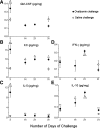

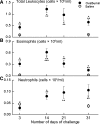
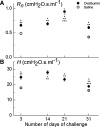
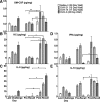

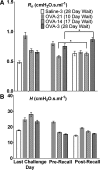
Similar articles
-
Cytokine and eosinophil responses in the lung, peripheral blood, and bone marrow compartments in a murine model of allergen-induced airways inflammation.Am J Respir Cell Mol Biol. 1997 May;16(5):510-20. doi: 10.1165/ajrcmb.16.5.9160833. Am J Respir Cell Mol Biol. 1997. PMID: 9160833
-
Sex-specific lung remodeling and inflammation changes in experimental allergic asthma.J Appl Physiol (1985). 2010 Sep;109(3):855-63. doi: 10.1152/japplphysiol.00333.2010. Epub 2010 Jul 15. J Appl Physiol (1985). 2010. PMID: 20634353
-
Experimental protocol for development of adjuvant-free murine chronic model of allergic asthma.J Immunol Methods. 2019 May;468:10-19. doi: 10.1016/j.jim.2019.03.002. Epub 2019 Mar 14. J Immunol Methods. 2019. PMID: 30880263
-
[Combined effects of neonatal Bacillus Calmette-Guerin vaccination and respiratory syncytial infection on experimental asthma in mice].Zhonghua Er Ke Za Zhi. 2006 Jun;44(6):420-4. Zhonghua Er Ke Za Zhi. 2006. PMID: 16836848 Chinese.
-
Compartmentalized transgene expression of granulocyte-macrophage colony-stimulating factor (GM-CSF) in mouse lung enhances allergic airways inflammation.Clin Exp Immunol. 1998 Aug;113(2):157-65. doi: 10.1046/j.1365-2249.1998.00652.x. Clin Exp Immunol. 1998. PMID: 9717963 Free PMC article.
Cited by
-
A theoretical model of inflammation- and mechanotransduction-driven asthmatic airway remodelling.Biomech Model Mechanobiol. 2018 Oct;17(5):1451-1470. doi: 10.1007/s10237-018-1037-4. Epub 2018 Jul 2. Biomech Model Mechanobiol. 2018. PMID: 29968161 Free PMC article.
-
Pathophysiology to Phenotype in the Asthma of Obesity.Ann Am Thorac Soc. 2017 Nov;14(Supplement_5):S395-S398. doi: 10.1513/AnnalsATS.201702-122AW. Ann Am Thorac Soc. 2017. PMID: 29161090 Free PMC article. Review.
References
-
- Bates JH, Wagers SS, Norton RJ, Rinaldi LM, Irvin CG. Exaggerated airway narrowing in mice treated with intratracheal cationic protein. J Appl Physiol (1985) 100: 500–506, 2006. - PubMed
-
- Cojocaru A, Irvin CG, Haverkamp HC, Bates JH. Computational assessment of airway wall stiffness in vivo in allergically inflamed mouse models of asthma. J Appl Physiol 104: 1601–1610, 2008. - PubMed
-
- Gajewska BU, Wiley RE, Jordana M. GM-CSF and dendritic cells in allergic airway inflammation: basic mechanisms and prospects for therapeutic intervention. Curr Drug Targets Inflamm Allergy 2: 279–292, 2003. - PubMed
-
- Hantos Z, Daroczy B, Suki B, Nagy S, Fredberg JJ. Input impedance and peripheral inhomogeneity of dog lungs. J Appl Physiol (1985) 72: 168–178, 1992. - PubMed
Publication types
MeSH terms
Substances
Grants and funding
LinkOut - more resources
Full Text Sources
Other Literature Sources
Medical

